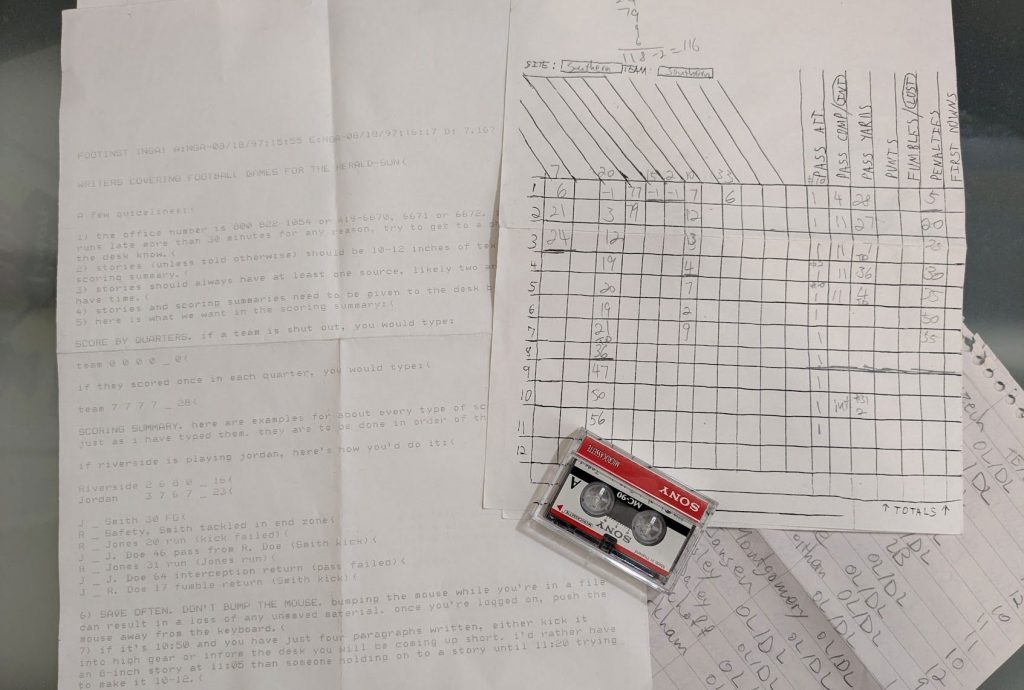On a recent visit to my parents’ house, I unearthed a binder that dated back to my freshman year in college. Tucked inside was a stash of artifacts from my early days covering high school football as a part-time correspondent for The Herald-Sun.
The treasure horde consisted of a mini cassette tape of postgame interviews (which I no longer have a compatible device to play), a couple hand-copied rosters, a hand-drawn scoresheet for keeping stats during games, and a few sheets of dot-matrix-printed instructions for how to type stories in a program so temperamental that the person who wrote the instructions had put in all caps “DON’T BUMP THE MOUSE,” because it could crash the program. In fact, the instructions advised, it’s best to move your mouse away from the keyboard once you’ve logged in.

These nearly three-decade-old artifacts were a nice nostalgic trip. They also got me thinking about how far afield my professional path has taken me — from writing about football to building websites, from talking about Most Valuable Players to discussing Minimal Viable Products, from wrestling with antiquated technology to helping build better technology. Along the way, I have also, among other things, designed graphics for science curriculum modules, written grant proposals, developed strategic plans, and advised senior leaders on tricky organizational challenges.
Yet, throughout that professional journey, I have relied on many of the same skills that I honed under the Friday night lights all those years ago. Here are five ways that covering high school football prepared me for every job I’ve had since.
Asking the right questions

Who caught the go-ahead touchdown? What play did they run? Where was the ball on the field? When in the game did that play happen? Why did the team choose to go for two? How did the receiver get open?
Who? What? Where? When? Why? How? These were basic questions that every game story I wrote needed to answer. They are the “5 W’s and H” that get drilled into students’ brains in Journalism 101 classes. And focusing on them has served me well in my career, no matter the job.
When I was planning an infographic for a K-12 science education module, those questions helped me grasp how my design would be used and what it needed to convey. When I was drafting a proposal to Duke University leaders to recommend significantly increasing graduate student financial support, those questions were crucial to understanding the complex interdependencies, explaining the challenges, and persuading the audience. When I was mapping out what content and data we needed for a redesign of a major government service’s website, some version of those questions surfaced seemingly every week as we worked through numerous user scenarios.
In every field, there are insights you need in order to accomplish your goals. Every field will have its own lingo and somewhat different techniques for gathering those insights. Peel away the jargon, though, and you’re essentially always asking who, what, where, when, why, and how. Those basic questions provide a useful starting point and framework for analyzing your problem, identifying your goal, and finding a path to your solution.
Staying cool on deadline

High school football games typically ended a bit after 9 p.m. All pages for the first edition of the newspaper had to be done by 11:30 p.m. That left 150 minutes to interview coaches and players, drive back to the office, tally up the game stats, write 300 to 500 coherent words that capture what happened in the game (preferably with a somewhat catchy opening), and ideally get it to the newspaper’s design and copy desk with 30 minutes to spare so they could do their part before deadline.
I spent the first 10 years of my career immersed in that fast-paced environment, and no deadline — in any job — has fazed me since.
It’s not just about becoming comfortable with really short turnarounds either. Working under tight deadlines on a daily basis taught me how to break down and manage projects of any length. Whether it’s an urgent COVID announcement that needed to be sent 15 minutes ago or a website redesign that will launch a year from now, the approach I honed from covering high school football helped: Plan meticulously in advance, identify what can be done right now and what can’t be done until later, take care of what you can control and don’t stress (too much) over what you can’t, have a backup plan for key pieces that might not materialize in time, know how much slack you can give your collaborators deadline-wise, and be willing to triage ruthlessly as the clock ticks down.
Juggling everything everywhere all at once

A player takes the handoff, slashes up the middle, and gets tackled. The play ends, and my work begins: Get eyes on the ball carrier’s jersey number so I know who it was. Calculate how many yards he picked up and add it to the running tally on my stat sheet. Note where the ball is spotted on the field. Glance up at the scoreboard to note the time. Look at the refs’ down marker to confirm what down it is. Scribble a one-line description of the play in my notepad, along with a detail that I might use in my story. Keep my eyes and ears open for sideline reactions that could help add color to the story. Mentally wordsmith a possible opening to the story if this turns out to be a key play in the outcome. Update the mental list of players I want to interview after the game. Check my watch and guesstimate when this game will end and how many minutes I’d have to write and send my story.
As you may have guessed, covering high school football was great practice in multitasking (or in doing lots of single-tasking in quick succession). Thanks to that experience, I became very comfortable managing lots of tasks and projects at the same time, which has been particularly useful when I’ve served in leadership roles.
Accepting imperfections

When I made my latest career shift and jumped into web development full-time, I had to adjust to working in an Agile environment. A lot of the jargon and ways of working were foreign to me, but one aspect came easily: accepting that we’re not going to build the perfect product.
This was a mindset that I had become familiar with from the start of my career. When you’re scrambling to write a story in 45 minutes or less, perfectionism is not a luxury you can afford. There’ll always be that more interesting quote you might’ve gotten if you conducted one more interview, that more clever turn of phrase you could’ve written if you dwelled on a paragraph for another 20 minutes, the additional color you could’ve squeezed in if your story’s word-count limit was 100 words longer. But with limited time and space, you have to learn when to move on.
Moving on, though, is not just stopping at whatever point you run out of time, space, or any other finite resource. It requires the ability to identify the most crucial aspects of whatever you’re working on and allotting sufficient resources to ensure those get done properly before worrying about the secondary components. That ability to prioritize and triage has been a key for many projects that I’ve worked on, whether it’s website redesigns, grant proposals, or user research.
Perceiving the forest from the trees

At the end of every football game I covered, I had a stat sheet full of numbers, a lot of notepad pages of play-by-play, and my memory of the action I just watched. It was my job to build a narrative out of all of those data points. What was the key to victory? Who were the top players? What does this game mean for the teams’ respective seasons? In short: What was the story here?
The ability to distill a lot of information into a clear story and succinctly convey it to an audience has been a crucial skill in my career. Like when I turned reams of historical data and strategic plans into a succinct narrative to convince the Alfred P. Sloan Foundation that we were the best choice for a million-dollar grant. Or when I turned copious notes from usability testing sessions into compact, actionable insights and recommendations for a website redesign. Or when I presented the 90-year history of the Duke Graduate School in a five-panel timeline exhibit.
———
Of course, those five attributes alone do not a career make, much less several different careers. I’ve acquired my share of additional training and experience via non-football means along the way. Yet, many of the core assets that I’ve drawn on time and again in every job have been the ones forged from those early days walking the sidelines on the gridiron, notepad and stat sheet in hand, a mini tape recorder in my pocket, and the ticking of an imaginary clock in my head as deadline drew near. 🏈
Stock images by (from top) Lucas Andrade, Leeloo the First, Stas Knop, Roman Odintsov, Polina Tankilevitch, and Kelly

